Wirring Identical Solar Panels in Series
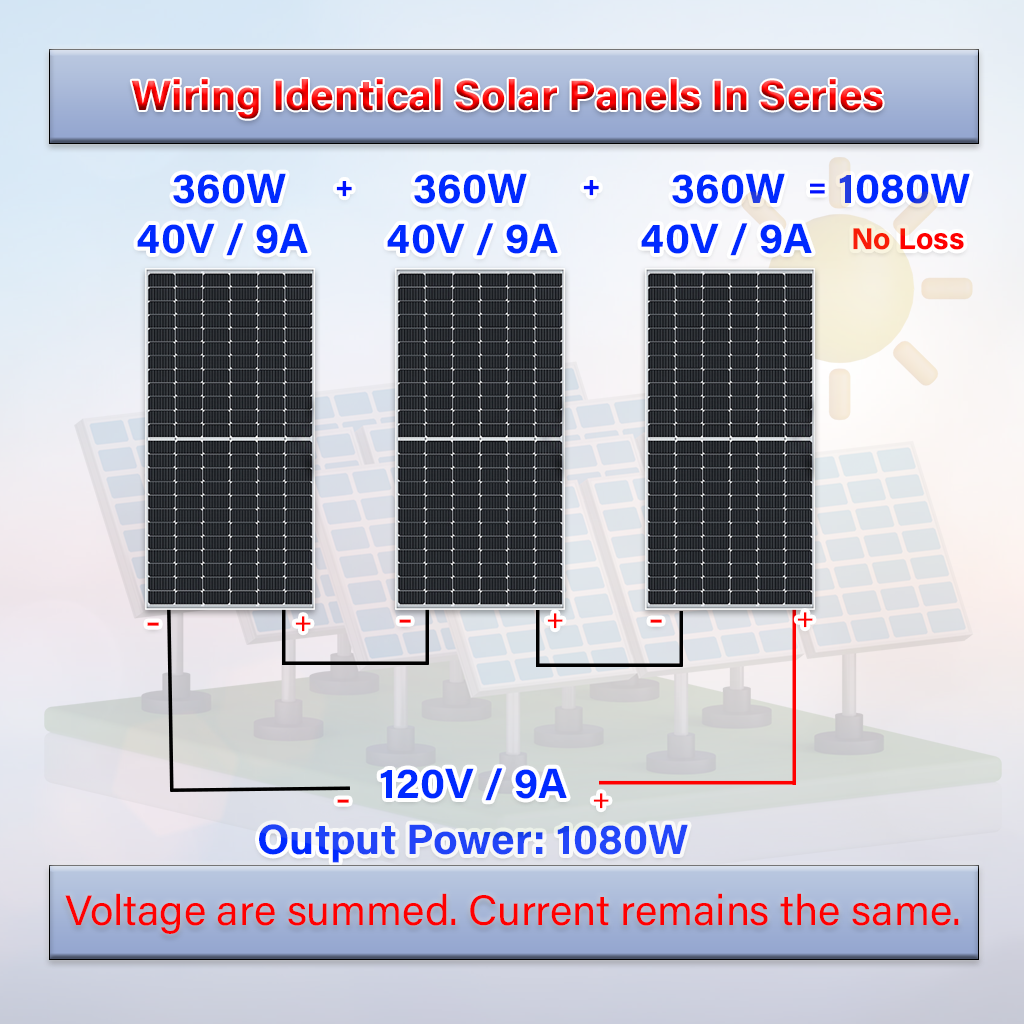
Connecting the positive terminal of one solar panel to the negative terminal of the following panel is known as wiring identical solar panels in series. With this setup, the output voltage is raised while the current is kept constant. A larger overall voltage output is achieved by connecting panels in series, since the total voltage across the array is equal to the sum of the individual panel voltages. When a higher voltage is needed for the intended use in order to effectively power devices or charge batteries, this configuration is beneficial. To preserve efficiency and safety, it is crucial to make sure that the wiring and componentry have enough current rating to withstand the higher voltage. Furthermore, a single shaded panel in a series can drastically lower the output of the entire array, therefore panel placement must be carefully considered.
Wirring Identical Solar Panels in Parallel
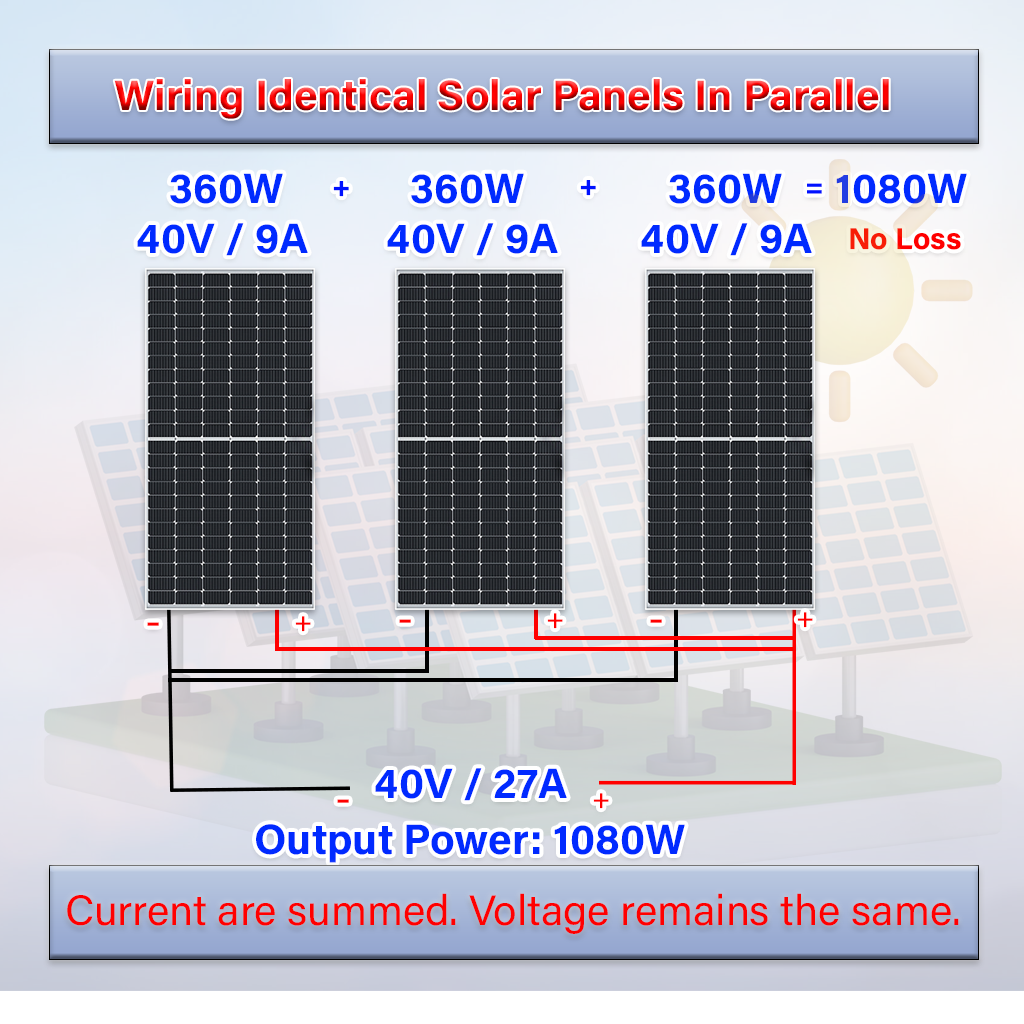
Connecting all of the positive and negative terminals of identical solar panels in parallel means connecting them all together. This combination increases the total current capacity while maintaining the same voltage output as a single panel. A larger total power output is produced when panels are connected in parallel because the total output current is equal to the sum of the individual panel currents. When a higher current is needed for the application to power devices or charge batteries efficiently, this configuration is advantageous. Additionally, it lessens shading problems since, unlike with series wiring, the output of shaded panels does not greatly impact the output of the entire array. But in order to preserve safety and functionality, it's crucial to make sure the wiring and other parts can withstand the increased current.
Wirring Different Solar Panels in Series
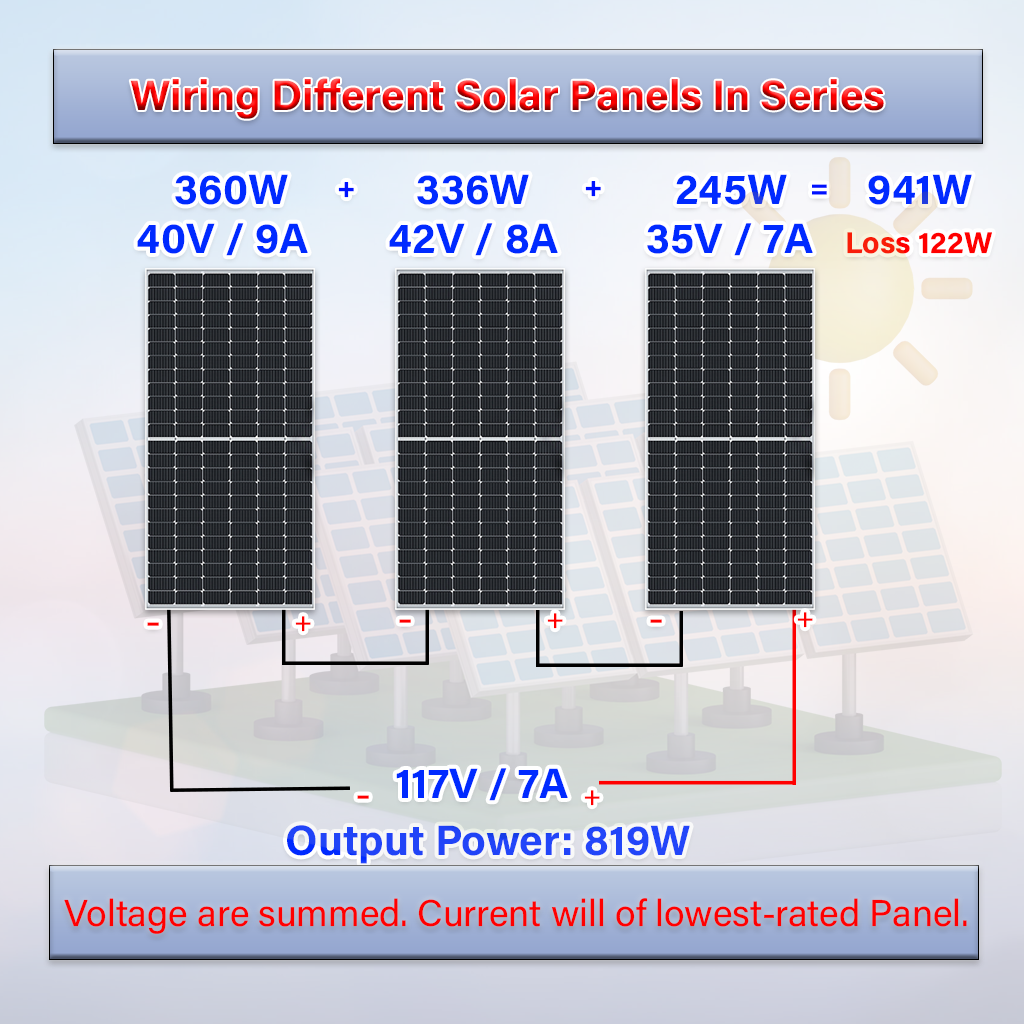
Regardless of the precise specifications of each panel, wiring multiple solar panels in series entails connecting the positive terminal of one panel to the negative terminal of the following panel. The voltages from each panel are combined in this design, which could lead to a larger overall voltage output. It is imperative to take into account the voltage and current ratings of every panel to guarantee compatibility and prevent any system component from being overloaded. Furthermore, mismatched voltage, current, and power characteristics of panels connected in series might cause performance problems, including decreased overall efficiency. To maximise the system's performance and safety, extra parts like voltage regulators or bypass diodes may need to be included, thus careful thinking is required.
Wirring Different Solar Panels in Parallel

All of the positive and negative terminals must be connected when wiring multiple solar panels in parallel, regardless of how they are specifically designed. The overall current capacity rises in this configuration, but the voltage output stays the same as the voltage of the highest-voltage individual panel. Panels connected in parallel produce an overall output current equal to the sum of their individual panel currents, which could lead to a larger total power output. Nonetheless, in order to guarantee compatibility and prevent overloading any system component, it is crucial to take into account the voltage and current specifications of each panel. Furthermore, mismatched voltage, current, and power characteristics of panels connected in parallel might cause performance problems, including decreased overall efficiency.
Wirring Identical Solar Panels in Series-Parallel
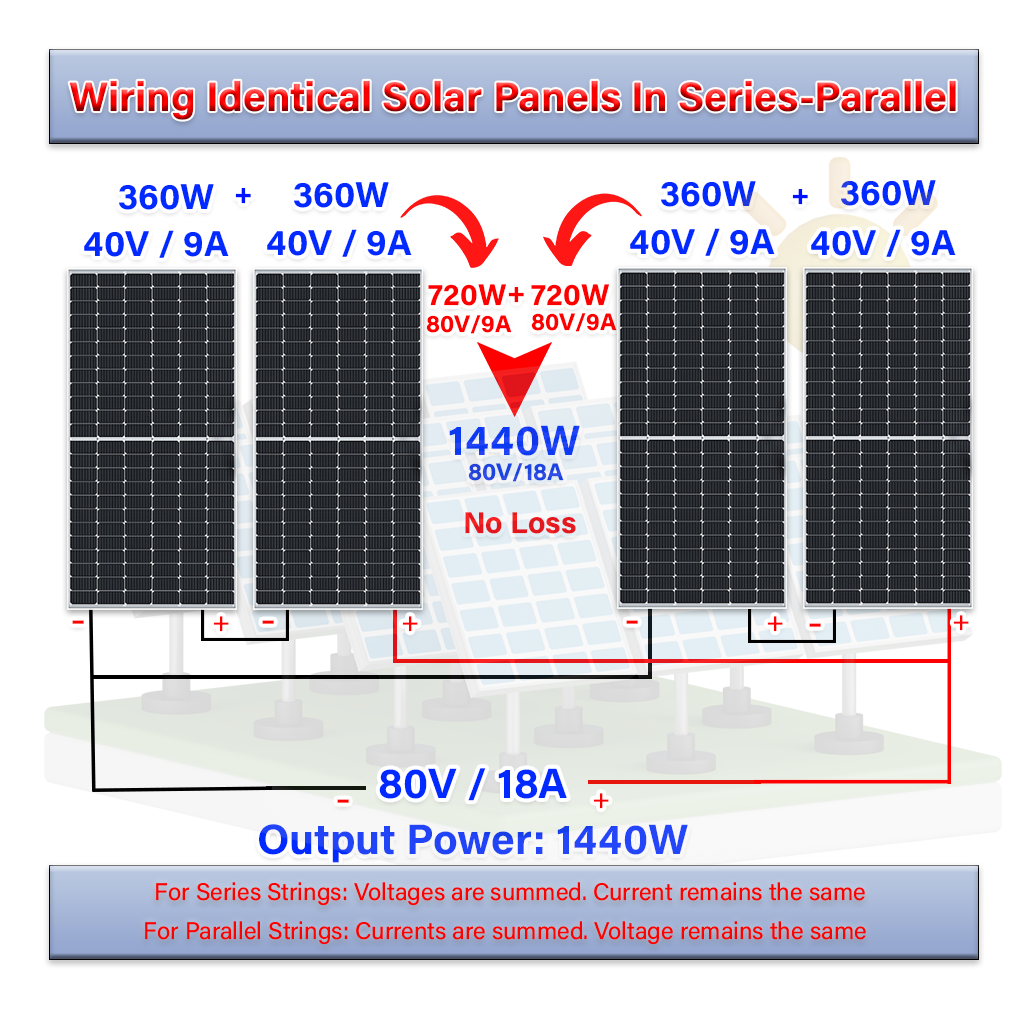 To balance the output of voltage and current, identical solar panels are wired in a series-parallel configuration using both series and parallel connections. The positive terminal of one panel is connected to the negative terminal of the following panel in a series string arrangement of identical panels that raises the total voltage. Next, all of the positive and negative terminals of these series strings are linked together in parallel configuration. This configuration raises the system's total current capacity while maintaining the voltage of each individual panel. It provides a balance between the higher current of parallel connections and the higher voltage of series connections, enabling effective power generation and use. But cautious consideration must be given to guarantee
To balance the output of voltage and current, identical solar panels are wired in a series-parallel configuration using both series and parallel connections. The positive terminal of one panel is connected to the negative terminal of the following panel in a series string arrangement of identical panels that raises the total voltage. Next, all of the positive and negative terminals of these series strings are linked together in parallel configuration. This configuration raises the system's total current capacity while maintaining the voltage of each individual panel. It provides a balance between the higher current of parallel connections and the higher voltage of series connections, enabling effective power generation and use. But cautious consideration must be given to guarantee
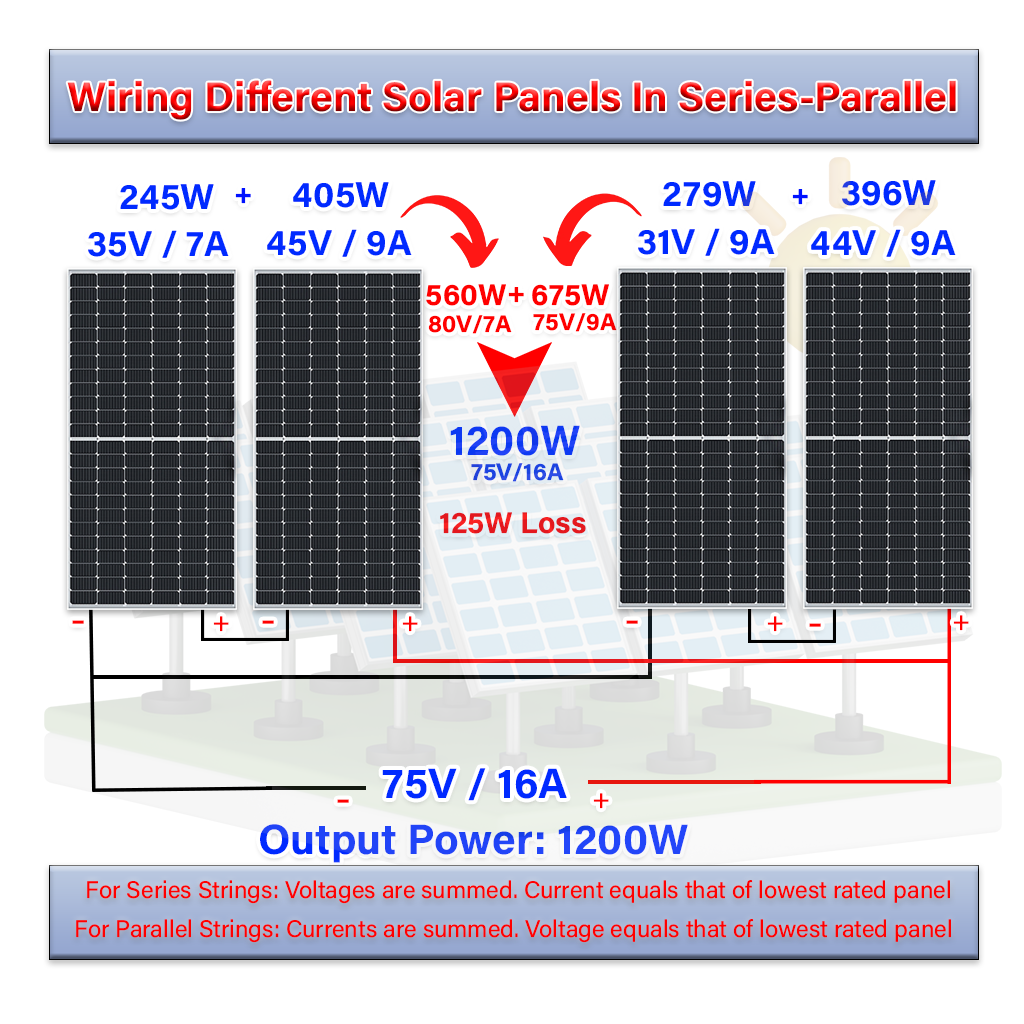 In order to balance the voltage and current outputs, wiring various solar panels in a series-parallel configuration requires a combination of series and parallel connections. To increase the overall voltage, the panels are first arranged into series strings, where the positive terminal of one panel is connected to the negative terminal of the following panel. Following that, all of the positive and negative terminals on these series strings—which are made up of various panels—are joined in parallel. With this configuration, power generation can be optimised by using panels with different output voltages and currents. Carefully matching the panels is necessary to guarantee compatibility and avoid problems like overloading or decreased performance. Furthermore, shading issues with a single series string may have an impact
In order to balance the voltage and current outputs, wiring various solar panels in a series-parallel configuration requires a combination of series and parallel connections. To increase the overall voltage, the panels are first arranged into series strings, where the positive terminal of one panel is connected to the negative terminal of the following panel. Following that, all of the positive and negative terminals on these series strings—which are made up of various panels—are joined in parallel. With this configuration, power generation can be optimised by using panels with different output voltages and currents. Carefully matching the panels is necessary to guarantee compatibility and avoid problems like overloading or decreased performance. Furthermore, shading issues with a single series string may have an impact







0 Comments